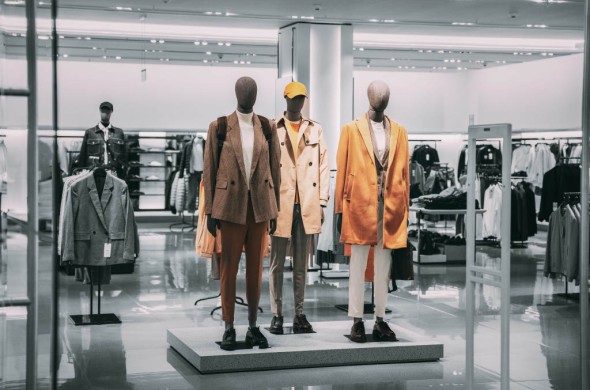In today’s rapidly evolving retail landscape, apparel brands across the Middle East and Africa (MEA) are under growing pressure to align with consumer demand for sustainability. As environmental awareness rises, so do expectations for brands to reflect eco-conscious values not just in their products, but in their physical retail environments. Recent market insights reveal that consumers in the UAE, Saudi Arabia, and the wider GCC Region.
Now prioritize sustainability when making purchase decisions in 2025, signaling a major shift in retail behavior across the region.
This trend is especially prominent in the UAE, where searches for terms such as “sustainable fashion” and “green retail” have seen consistent growth. Coupled with robust projections for retail sector growth and the region’s ambitious climate goals, there’s a clear call to action for brands: sustainability in store design is no longer optional, it’s a strategic imperative.
Forward thinking apparel retailers are now integrating environmentally responsible practices into the very fabric of their retail spaces, from modular layouts and low impact materials to energy efficient systems. In doing so, they’re not only enhancing their environmental performance but also creating immersive, values driven shopping experiences that resonate deeply with today’s eco conscious consumers.
This growing eco-conscious movement presents both a challenge and an opportunity: how can apparel retailers appeal to green minded shoppers while delivering immersive, aesthetically pleasing experiences in a competitive retail landscape? The answer lies in sustainable retail store design, a transformative approach that combines environmental stewardship with brand storytelling, modular innovation, and cost efficiency.
Why Sustainable Store Design is Becoming Essential in Apparel Retail
The retail landscape in the Gulf Cooperation Council (GCC) countries is undergoing a radical transformation. With the UAE retail sector projected to surpass AED 300 bln by 2026, sustainability is emerging not just as a compliance requirement, but as a market differentiator. Regional sustainability goals, such as the UAE Net Zero by 2050 initiative, are pressuring brands to align with broader environmental mandates, while consumers are increasingly rewarding those that do.
At the same time, energy consumption in commercial buildings accounts for approximately 40% of global energy usage, making retail environments critical battlegrounds for climate conscious change. Apparel brands, particularly those launching or expanding within premium malls or mixed use developments, must therefore rethink how they approach their retail design services.
Trends Shaping Sustainable Retail Store Design in the MEA Region
To meet rising expectations, apparel brands must embrace a series of design innovations that reduce environmental impact while enhancing customer engagement. Here are the most impactful trends:
1. Modular and Flexible Layouts
Modular store designs allow for adaptive, reconfigurable layouts that reduce the need for repeated construction and waste. These systems use prefabricated components that are reusable or repurposed, aligning with circular economy principles. For brands operating across multiple locations, this design strategy also streamlines rollout and reduces long term costs.
2. Eco-Friendly and Locally Sourced Materials
Using FSC certified wood, recycled metal, organic textiles, and VOC free paints significantly lowers a store's environmental footprint. In the GCC, sourcing materials locally also reduces transportation emissions and supports the regional economy. This approach resonates with sustainability focused consumers, most of whom say they prefer brands that are committed to ethical sourcing.
3. Energy Efficient Fixtures and Smart Systems
LED lighting, motion sensors, smart HVAC systems, and natural lighting solutions help reduce energy consumption. Some apparel retailers are incorporating IoT enabled energy monitoring systems that optimize consumption in real time, cutting operational costs while showcasing innovation.
4. Biophilic Design and Green Elements
Green walls, potted plants, and nature inspired elements contribute not only to sustainability but to consumer well being. Studies show that biophilic design increases dwell time and boosts customer satisfaction, key performance indicators for any retail operation.
5. Digital Integration to Reduce Physical Waste
The shift toward digital signage, touchless checkout, and interactive screens minimizes paper usage and provides dynamic ways to tell a brand's sustainability story. For example, screens that share a garment's life cycle or carbon footprint reinforce transparency and build consumer trust.
Balancing Sustainability, Aesthetics, and Cost
While the benefits of sustainable retail design are clear, implementation is often hindered by perceptions of high initial costs, especially in high footfall premium malls across Dubai, Riyadh, and Doha. However, forward looking retailers are adopting smart strategies to balance aesthetics and eco consciousness without compromising on budget:
- Phased Fit Out Implementation: Rolling out sustainability features in phases allows brands to manage capital expenditure over time while still demonstrating progress to customers.
- Value Engineering for Sustainable Materials: New generation materials such as recycled composite panels, eco resins, and bamboo alternatives offer high design flexibility at competitive prices.
- Leasing vs. Owning Fixtures: Leasing modular display systems and furniture reduces upfront costs and increases flexibility for store reconfiguration or brand pivots.
- Collaboration with Design Specialists: Engaging with experienced retail store designers familiar with regional sustainability standards ensures efficient project execution and regulatory compliance.
These approaches are already paying off, investing in a modular and energy efficient store fit out, the brand reduced its annual operational costs, while increasing customer footfall within the first quarter post launch.
Aligning Retail Environments with Regional Sustainability Goals
As governments in the GCC continue to push aggressive sustainability agendas, retail brands that align with these goals are better positioned to receive support, whether through incentives, green certifications, or leasing opportunities in eco-rated developments.
The Dubai 2040 Urban Master Plan, for instance, places sustainability at the core of city planning, influencing how retail real estate will evolve. Retailers that integrate green building standards such as LEED, Estidama, or GSAS into their store development processes will be better aligned with urban planning objectives and increasingly preferred by landlords and developers.
Creating Immersive, Sustainable Brand Experiences
Beyond cost and compliance, sustainable store design serves a higher purpose: delivering authentic, values driven experiences that resonate with eco conscious consumers. In an age where around 73% of Gen Z shoppers in the GCC say they are more likely to buy from environmentally responsible brands, store environments must embody a brand’s sustainability ethos not just through messaging, but through design, materials, and operational practices.
Retailers take advantage of brand design services to ensure that every aspect of their store, from visual merchandising to lighting and packaging, reinforces a consistent eco-conscious identity. These elements are no longer optional; they are essential to customer loyalty and long term success.
Looking Ahead: The Future of Sustainable Apparel Retail in the MEA
The path toward greener retail is not a linear one; it requires agility, strategic investment, and a commitment to innovation. But the payoff is clear: increased brand relevance, lower operational costs, and stronger alignment with regional consumer values.
In a competitive retail landscape increasingly shaped by conscious consumption, apparel brands that invest in sustainable retail design will not only lead the market but help shape its future. Whether it’s through adaptive store formats, smart energy solutions, or biophilic design principles, the opportunity is here and now.
Final Thoughts
Sustainability is no longer a marketing buzzword; it's a fundamental business imperative. For apparel brands in the MEA region, sustainable retail store design is a critical lever for differentiation, growth, and long term success. By leveraging retail design services that are rooted in sustainability and supported by modern technologies, brands attract eco conscious consumers and turn their retail spaces into purpose driven brand assets.
As regional demand for ethical and environmentally friendly fashion continues to rise, the question is no longer whether to embrace sustainable store design, but how soon you begin.
Read our latest insights on the trending Retail design services and brand design strategies, as well as ideas and perspectives that explore the trends shaping the future of business and society. Our consultancy services go hand in hand with these insights, confirming our position as industry leaders. Get in touch to find out more about our consulting services and industry expertise.



